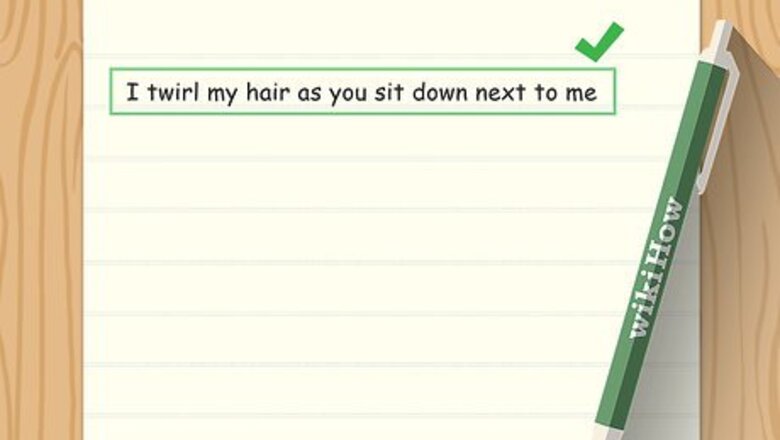
views
X
Research source
Crafting Your Poem

Start with a simple prose statement. If you've taken notes in a journal, pull out a statement or phrase that you want to write about. This will be the basic subject of your poem. Your initial statement doesn't necessarily need to be "poetic." You'll find the poetry as you open it up and dig deeper into it. For example, you might have seen a little girl in the park wearing a blue dress. All you need at this point is the phrase "The girl in the park was wearing a pretty blue dress."
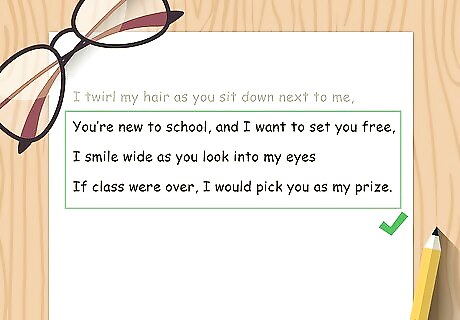
Expand the description of your subject. Brainstorm words and phrases that help open up each of the key words in your statement. Find similes and metaphors that you can use to make your description unique. For example, the blue dress may be the color of the sky. It's not all that original to say the girl was wearing a dress the color of the sky. But if you say you saw a girl dressed in sky, that's getting a little more poetic. Think about the point you want to get across in your poem. If you're writing the poem about the girl in the blue dress, for example, you could write about the contrast between the happiness of the girl and the sadness traditionally associated with the color blue. Or you could write about how carefree the child seems and contrast that to the seriousness of adults and of the color blue.
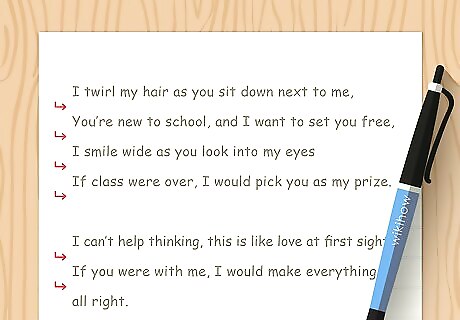
Break lines to enhance rhythm and meaning. The line break is what makes a piece of writing poetry, rather than prose. Line breaks give every poem a rhythm, even if you're writing in free verse with no rhyme or other rigid structure. To find the best places to break your lines, read your poem out loud. Including an exaggerated pause between the lines will help you find the rhythm. Try to break your lines so that each line of the poem is a complete thought in and of itself. When read separately, your reader may get a different idea than they would reading the poem as a whole. This creates depth in your poem and gives your reader something to think about long after they've finished reading your poem.

Go longer in your first draft. It's far easier to cut than it is to add. When you sit down to write your first draft, don't worry about the form or length you've chosen. Write as many words as you think you need to get your point across. You may also want to write several different drafts of the same poem. If you think of more than one approach, write all of them down so you can decide later which works best. If you have any alternate words or descriptions you're thinking about, include them in the margins (if you're handwriting your draft) or at the bottom of the page (if you're typing).
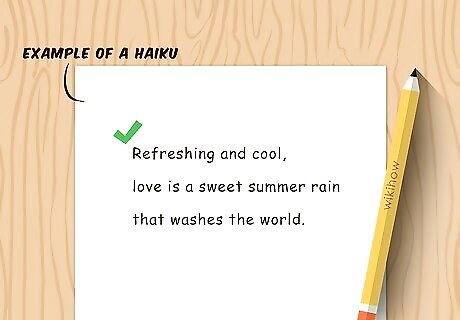
Experiment with traditional forms. If you've never written a short poem before, the haiku presents a simple structure that can be an easy place to start. It's also a popular and recognizable form. You'll write 17 syllables through 3 lines of text, most commonly in the 5-7-5 formula. Haiku teaches the discipline you need to write short poems in other styles, because not just every word, but every syllable counts. Make friends with a thesaurus, as you may need it to find similar words to fit the form.
Editing Your Work

Step away from your poem. When you sit down to edit, you want to be able to look at your poem with a fresh eye. For a short poem, you may practically have it memorized by the time you finish writing it. Don't look at it for a couple of days. If you try to edit your poem immediately after you've written it, you won't be able to look at it with the objectivity you need as an editor.
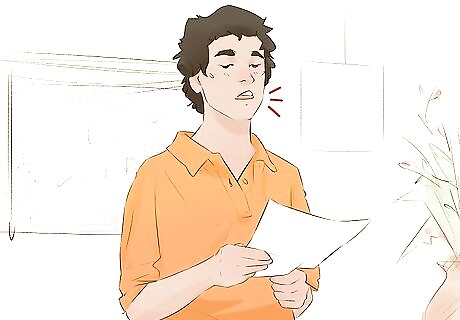
Read your poem aloud. Reading aloud is the easiest way to find the internal rhythm of a poem. You'll also be able to tell more easily if something doesn't work. Experiment with different line breaks and structures as you read. If you stumble over a word or phrase when reading aloud, change it so that it flows more smoothly – unless, of course, you want to write something that's a tongue twister. When something isn't sounding like you think it should, highlight or underline it. Go to a dictionary or thesaurus and experiment with different synonyms until you find just the right word.

Identify the core of your poem. Within your poem, there will be a single word or phrase that signifies the emotional core. Everything else in your poem should relate to that core in some way. If it doesn't, you can remove it. Remove anything that distracts from or competes with the core. In a short poem, you want to get right to the point. You don't have room to misdirect your readers.

Cut away everything that isn't needed. Going line by line, think about each word. Delete every word that isn't necessary for the reader to make sense of the poem and understand its core meaning. Start with small words such as "a" and "the." Try to make your language as compact as possible. For example, if you have "a girl wearing a blue dress," your first step is to remove the articles. "Girl wearing blue dress" is getting more poetic, but maybe you don't need "wearing" either. You're left with "girl blue dress," which may not make much sense. But if you swap the order of the words, "blue-dressed girl" conveys the meaning of the original statement without any fluff.
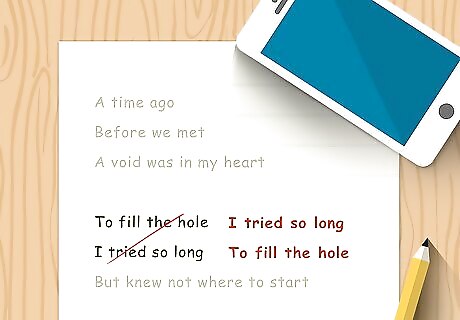
Change the order of your lines. Editing a poem is about more than the words you choose to include. You can move things around to add suspense or create a different mood. Swap lines around and think about how it changes the poem. If you've written something in chronological order, reverse it so that the last line is first and the reader backtracks to the beginning. Remove a line and see how it affects your poem. If it doesn't change the meaning of the poem, it may be better left out.
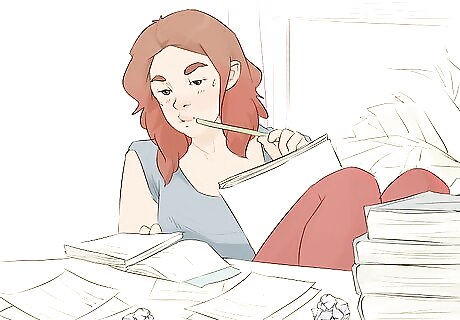
Make multiple revisions. Many poets will tell you that they never consider a poem to be "done." Even after a poem is published, you can still go back and change something that you think could be improved. Don't be afraid to go back and look at your poem 6 months or even a year after you've written it. At that point, you may have some new ideas on how it could be improved. If you write regularly, you'll become a better poet. The poet you are after a year of practice may have a better way to convey a message than the poet you were when you wrote your first poem.
Brainstorming Ideas

Go for a walk. Sitting outside is a good way to find ideas for poetry. Take a notebook and a pen (or your smart phone) to a nearby park or coffee shop. Walk around for a bit, then find a place to sit and observe. Take off your headphones so you can take in the world around you using all of your senses. Make an effort to look around and see everything around you. Allow your mind to wander, and jot down ideas that you get. Don't worry about whether they're "good" ideas, or even whether they make sense. You can sort through them later.

Eavesdrop on conversations. Sit in a crowded restaurant, pub, or café and pay attention to those around you. Keep your notebook open and jot down snippets you hear. You'll likely not be able to follow an entire conversation from beginning to end, but that's not the point. Hearing a phrase out of context often conjures up different imagery than if you'd known what the person was talking about. Additionally, you may mishear someone's words – especially in a busy place with lots of people talking. What you thought you heard may be more poetic than what they actually said.
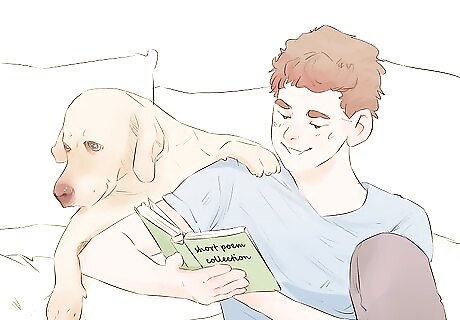
Read other poetry for inspiration. To write good poetry, you need to read good poetry. Look for poetry published online, or check out books of poetry from your local library. If you find a poem you like, dissect it to figure out how it works. Ask yourself what choices the poet made and how those choices made the poem better. When you find a particular style that you enjoy, find other poets that write in a similar style. Search the poet's name online, and look for other poets who are associated with them. For example, the poet may have had a reading with another poet. Anthologies are another good way to find many different poets writing in similar styles, or about similar subject matter. There's a fine line between inspiration and plagiarism. If you're directly inspired by a particular poem, consider writing your poem "for" or "after" the original poet. That way your work connects back to the original.
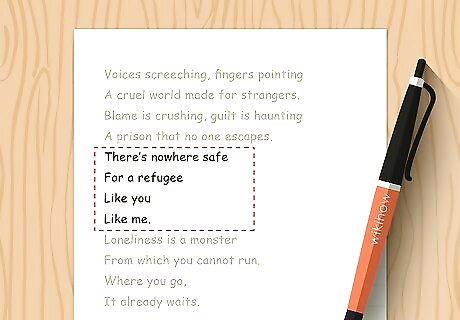
Cut an idea from a longer poem. If you already write longer poems, look for a couple of lines or a particular image that really sticks with you. See if you can borrow that image to create a shorter poem. For example, you may have mentioned the sunset in a longer poem about the ending of a relationship. That sunset could be the subject of a short poem on its own. You can also do this with a particular turn of phrase that you really like. Take that phrase and turn it around in your head. Think about how you could approach it from a different angle, or use it in a different way.




















Comments
0 comment